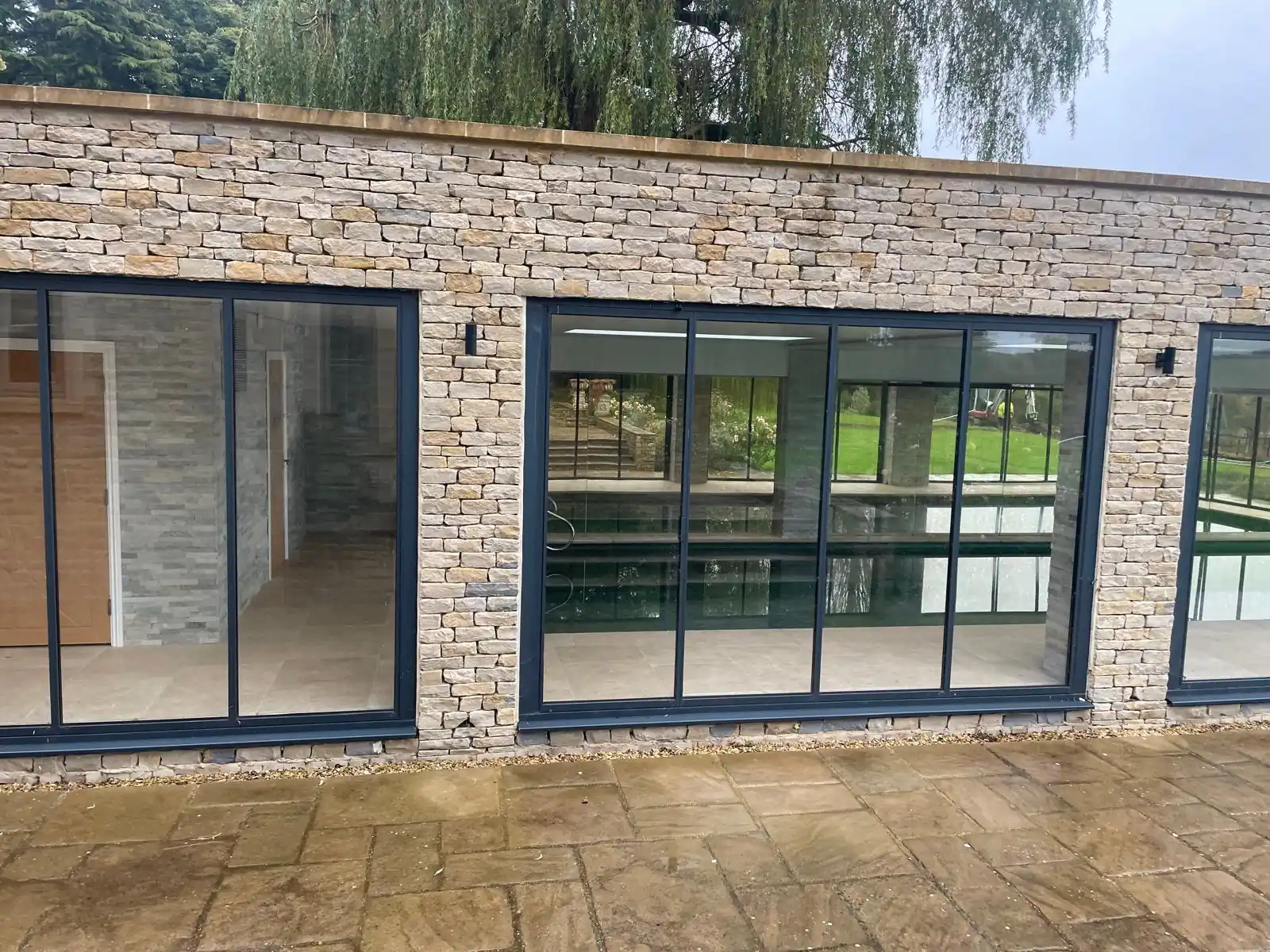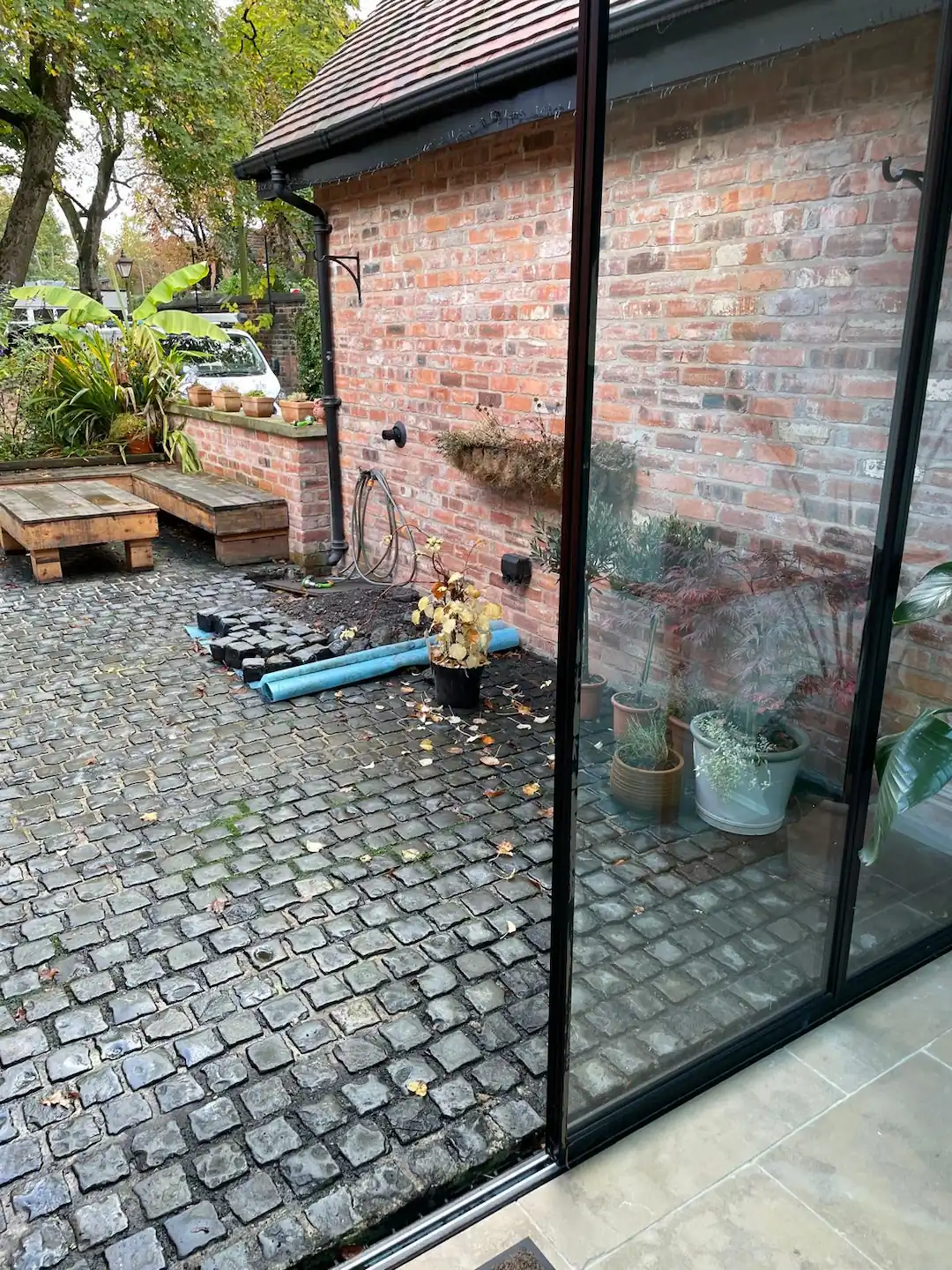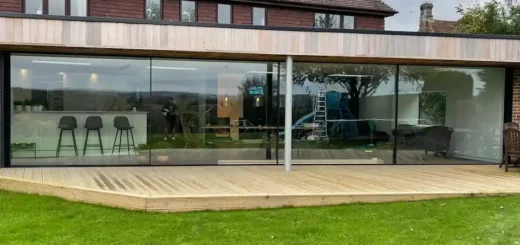Modern Glass Doors: Types and Options
Table of Contents
Modern glass doors combine clean lines with expansive glazing, bringing natural light and style to British homes. Recent advances in thermal efficiency, coupled with increasingly slim frame designs, have made these systems ideal for both period properties and new builds.
Types of Modern Glass Doors
Glass doors have evolved beyond traditional designs into sophisticated systems that suit contemporary style preferences.

Slimline Sliding Doors
Slim-profile sliding panels characterise many modern glass doors, running on precision-engineered tracks with astonishingly thin frames. The innovative track systems allow panels weighing up to around 400kg to glide smoothly using just fingertip pressure.
Unlike older patio door designs, modern slimline sliding doors can span entire walls, with frames as thin as 20mm between panels.
Multi-track systems expand the possibilities, often enabling two, three, four, or six panels to move independently.
The engineering behind these modern glass doors allows panels to stack either to one side or split to both sides, depending on the available space and desired functionality. Advanced roller mechanisms ensure years of reliable operation while maintaining the minimal appearance that makes these systems so appealing.
Opening Configurations
The flexibility of modern glass doors in sliding formats allows for varied panel arrangements. Two-panel configurations work well for standard openings, while larger spaces might benefit from multiple sliding panels. Each panel glides on dedicated tracks, with the option to include fixed panels for larger spans where not all sections need to open. Advanced thermal breaks and weather sealing maintain comfort without compromising the sleek appearance.
Frameless Glass Doors
Modern interior glass doors achieve their purest form in frameless designs. These sophisticated systems use toughened glass panels that seem to float between spaces, supported by discrete patch fittings and floor pivots. The structural strength comes from the glass itself – typically 10mm or 12mm thick toughened panels – while clever engineering keeps hardware minimal and unobtrusive.
The appeal of frameless modern glass doors lies in their ability to divide spaces without visual barriers. High-quality patch fittings, often in brushed stainless steel or matte black, secure the glass panels while maintaining the minimal aesthetic.
Bifolding Door Systems
In bifold doors, each panel links to its neighbour via sturdy hinges while running on a precisely engineered track system. The slim sight lines when closed can rival those of sliding systems, yet these doors can fold completely away to create wide, unobstructed openings.
Top-hung systems transfer the weight to the beam above, allowing for minimal bottom tracks that reduce trip hazards. Modern glass doors in bifold configurations typically feature magnetic door catches and finger-safe gaskets between panels. Intermediate panels can incorporate traffic doors for everyday access without opening the entire system.

Slide and Turn Doors
Slide and turn doors merge sliding and pivoting movements into one system. Unlike bifolds, which fold panels together, slide and turn doors allow each panel to move independently along the track before pivoting to stack.
This design offers greater flexibility in how you open the space while maintaining excellent thermal performance when closed.
The panels stack perpendicular to the frame, taking up less space than traditional folding doors.
Low-threshold options make these modern glass doors particularly suitable for indoor-outdoor situations where level access is required. Their versatility stems from the ability to open just one panel for ventilation or the entire system for maximum opening width.
Modern Glass Door Materials
The materials used in modern glass doors have improved substantially over the past decade. Advanced manufacturing processes allow for stronger, more thermally efficient frames while maintaining slim profiles that modern homes demand.
Aluminium Frame Options
Modern glass doors made from aluminium offer exceptional strength-to-width ratios. Current manufacturing techniques produce frames that measure just 20mm between panes while supporting glass units weighing up to 400kg. Modern exterior glass doors incorporate polyamide thermal breaks – strips of reinforced plastic that separate the inner and outer frame sections, preventing heat transfer through the metal.

Powder-coated finishes on aluminium modern glass doors provide lasting durability against UV and weather exposure. The coating process involves electrostatically applying dry powder to the frame sections, then curing them at high temperatures to create a tough skin. This produces a consistent, even finish that resists scratching and fading far better than traditional wet paint methods.
Modern glass doors in aluminium often feature dual-colour options – different finishes for interior and exterior faces. This allows the outer frame to complement external architecture while the inner surface matches internal colour schemes. The frames maintain their appearance without regular maintenance beyond occasional cleaning with soap and water.
Steel-Look Frames
The minimalist aesthetic of modern glass doors reaches new heights with steel-look aluminium systems. These frames replicate the slender profiles of traditional steel windows while offering better thermal performance. The distinctive squared edges and narrow sightlines suit both contemporary builds and renovated industrial spaces.
Glass room dividers in this style often incorporate grid designs, creating a strong geometric pattern that adds visual interest without blocking light. The robust construction of these modern glass doors allows for larger panel sizes than standard aluminium frames, though the total weight must still fall within specified limits for smooth operation.
Glass Specifications
Modern doors increasingly feature advanced glass units that combine multiple performance attributes. Today’s modern glass doors typically use toughened safety glass on both sides of an argon-filled cavity, with special coatings that reflect heat while allowing light through. For areas requiring extra thermal efficiency, triple-glazed units offer U-values as low as 0.8 W/m²K.
Frosted glass options for modern glass doors now extend beyond traditional acid-etched finishes. New printing techniques allow for graduated opacity patterns, while ceramic frit coatings create durable decorative effects that won’t wear off. The glass itself comes in various tints and finishes, from ultra-clear low-iron glass to subtle bronze or grey shades that reduce glare.
Solar control glass in modern glass doors helps maintain comfortable indoor temperatures year-round. These specialised coatings block up to 80% of solar heat gain while maintaining high levels of natural light transmission.
Modern Glass Door Design Options
The design choices available for modern glass doors extend far beyond basic frames and panels. Current manufacturing capabilities allow for highly personalised systems that match specific architectural styles while maintaining optimal performance.

Frame Colours and Finishes
Modern glass doors now come in an extensive range of powder-coated finishes that outlast traditional paint. Beyond standard whites and greys, contemporary doors feature metallic textures, wood-grain effects, and dual-colour options that let you specify different finishes for interior and exterior surfaces. The coating process creates a tough surface that keeps its visual appeal despite years of use.
Living room glass doors benefit particularly from these finish options, as they often need to work with existing colour schemes. The latest modern glass doors include textured finishes that add subtle depth to frame surfaces, while anodised options provide rich, deep colours that resist fading and wear. Each finish undergoes rigorous testing to ensure it maintains its appearance despite exposure to sunlight and weather.
Security Features
The hardware in modern glass doors integrates security features without compromising aesthetics. Multi-point locking systems hide within the frame, engaging automatically when the door closes. These mechanisms provide superior security while maintaining the minimal appearance that makes modern glass doors so appealing in current architectural designs.
Glass Options and Privacy
Modern patio doors offer various glass types to suit different privacy needs. Clear glass maximises views in modern spaces, while acid-etched panels provide privacy without blocking light. Gradient patterns allow for partial screening – clear at eye level for views, becoming progressively more opaque towards the top or bottom of the panel.
The latest modern glass doors include switchable privacy glass that changes from clear to opaque instantly. This technology suits spaces where privacy needs change throughout the day, providing a sophisticated alternative to traditional blinds or curtains. These systems work particularly well in glass door designs where traditional window coverings would detract from the clean lines.
Integral Blinds
Modern glass doors equipped with integral blinds offer clean, dust-free light control. The blinds sit between the glass panes in a sealed, maintenance-free environment. Magnetic controls allow smooth operation without compromising the door’s thermal performance or adding visible control mechanisms to the frame.
These systems suit both residential and commercial settings, where modern glass doors must balance privacy with light transmission. The blinds come in various styles, from simple venetian designs to pleated options that provide better insulation.
Handle Designs
Modern folding doors often feature handles that combine practicality with refined aesthetics. Flush handles sit level with the frame when not in use, maintaining clean sight lines while providing secure grip when needed. Pop-out handles emerge from the frame only when activated, then retract smoothly after use.
Modern interior glass doors often use minimal handle designs that complement rather than compete with the overall appearance. Stainless steel and powder-coated options match frame finishes precisely, while leather-wrapped variants add tactile warmth to contemporary doors. Each handle design undergoes extensive testing to ensure smooth operation despite frequent use.
Modern Glass Door Installation
Installing modern glass doors requires careful planning and precise execution. The success of any installation depends on accurate measurements, proper preparation of the opening, and attention to technical details that affect long-term performance.
Opening Preparations
Modern glass doors need robust structural support above the opening. Steel beams or reinforced concrete lintels carry the weight, while the surrounding walls must provide adequate fixing points for the frame. The latest modern glass internal doors come in bespoke sizes to fit specific openings, reducing the need for extensive building work.
Living space renovations often involve removing existing double doors or windows to create larger openings. Modern glass doors require level thresholds and plumb walls to operate properly. The preparation process includes checking wall materials, identifying potential water ingress points, and ensuring adequate drainage paths beneath the threshold.

Threshold Options
Modern glass doors offer various threshold designs to suit different locations and uses. Rebated thresholds provide excellent weather protection for exposed positions, while ultra-low options create level access between spaces.
The engineering behind these systems ensures reliable operation while maintaining a sleek design that suits current architectural trends.
Natural light flow improves with properly installed modern glass doors that sit perfectly level in their openings. Precision-engineered threshold sections include built-in drainage channels that direct water away from the building.
These components work together to prevent water ingress while maintaining the clean lines that modern design demands.
Weather Performance
The performance of modern glass doors depends heavily on proper installation techniques. Each system includes multiple layers of protection against wind and rain, from brush seals to compression gaskets. These components require precise adjustment during installation to maintain their effectiveness over time.
Modern glass doors with advanced weather protection suit even exposed coastal locations. The frame designs include pressure-equalisation chambers that prevent wind-driven rain from penetrating the seals. A sense of continuity between spaces remains possible while maintaining comfortable internal conditions in all weather.
Installation Process
Professional installation teams follow strict procedures when fitting modern glass doors. They begin by checking structural integrity, then ensure perfect alignment. The process includes testing operation patterns, adjusting rolling mechanisms, and calibrating locking systems to provide smooth, reliable performance from day one.
Modern Glass Doors FAQ
Can modern glass doors be fitted in old houses?
Installing modern glass doors in period properties requires careful assessment of the existing structure. Load-bearing calculations must account for original building materials and construction methods, while installation techniques need adaptation for uneven walls and floors. The frame fixing methods vary based on wall composition, from solid brick to timber frame structures. Thermal efficiency improvements might be needed in the surrounding walls to match the performance of new doors.
Are modern internal doors with glass suitable for bathrooms?
Modern internal doors with glass work well in bathrooms when specified correctly. Special finishes protect frames against moisture, while toughened safety glass with privacy options maintains both security and discretion. Marine-grade hardware resists corrosion even in high-humidity environments. Proper ventilation design helps prevent condensation issues, particularly in winter months.
What’s the difference between modern glass doors and traditional French doors?
Traditional French doors feature thicker frames with smaller glass panels, while current designs emphasise minimal frames and larger glazed areas. Modern systems offer better thermal performance and security features, including multi-point locking and advanced glass technology. The operating mechanisms have also improved, with smooth-running gear systems replacing basic hinges. Contemporary doors typically weigh more due to larger glass panels, requiring more robust support structures. These improvements result in better draught exclusion and smoother operation.
How wide can modern glass doors span?
Door spans depend on the chosen system and structural support available. Engineering calculations determine the maximum width based on glass weight, frame strength, and building regulations. The opening mechanism – sliding, folding, or fixed panels – affects possible configurations. Panel sizes vary between manufacturers, with some specialising in extra-wide options.
Can modern glass doors be retrofitted?
Retrofitting modern internal glass doors often requires adaptation of existing openings. Professional surveys assess structural integrity, reveal hidden issues, and determine necessary modifications. Building regulations might require additional ventilation or fire safety measures. The process typically includes upgrading lintels, ensuring proper support, and potentially adjusting floor levels.
What safety features do modern glass doors have?
Modern door systems incorporate multiple safety elements. Toughened safety glass breaks into small, rounded pieces rather than sharp shards, while laminated options hold together if broken. Finger-safe gaskets between panels prevent trapped digits, and soft-close mechanisms reduce accident risks. Anti-slip threshold options improve safety in wet conditions.
Can modern internal glass doors be soundproofed?
Modern internal glass doors can achieve impressive acoustic performance with the right specification. Double-glazed units with different glass thicknesses reduce sound transmission, while special acoustic seals around the frame limit noise leakage. Proper installation proves essential for maintaining acoustic properties. Adding laminated glass layers improves sound reduction even further.
Can modern glass doors be colour matched?
Powder coating technology allows precise colour matching to existing elements. RAL colour systems provide thousands of standardised options, while custom colours can match specific samples. The coating process ensures consistent finish quality and excellent durability. Surface textures range from matt to gloss, with special finishes like metallic effects also available.
What’s the difference between interior and exterior modern interior doors with glass?
Modern interior doors with glass differ from exterior versions in several key ways. Interior systems focus on sound insulation and privacy rather than weather resistance, typically using simpler sealing systems and lighter-weight glass. Thermal performance requirements vary widely, with interior doors needing less insulation. Hardware choices also differ, with external doors requiring more robust security features and weather-resistant finishes.
Can modern glass doors be fitted with Georgian bars?
Georgian bars suit both traditional and contemporary settings when properly designed. Surface-mounted options maintain the sealed unit’s performance while providing authentic appearance. Bars between glass panes offer easier cleaning but might look less authentic. Current manufacturing techniques allow for slim profiles that complement modern door designs.
How do you choose between different modern glass door systems?
Selecting the right door system depends on multiple factors including available space, intended use, and architectural style. Opening mechanisms affect both practicality and aesthetics – sliding doors suit areas without swing space, while folding systems offer wider apertures.
The installation location influences material and finish choices, with coastal areas requiring more robust specifications than sheltered urban settings. Local planning restrictions, building regulations, and insurance requirements might also limit options in certain situations.
About SunSeeker Doors
With over 20 years of experience, SunSeeker Doors remains at the forefront of door design with our quality-tested patio doors and related products, including the bespoke UltraSlim aluminium slide and pivot door system, Frameless Glass Doors, and Slimline Sliding Glass Doors. All of our doors are suitable for both internal and external use.
To request a free quotation, please use our online form. You may also contact 01582 492730, or email info@sunseekerdoors.co.uk if you have any questions.




